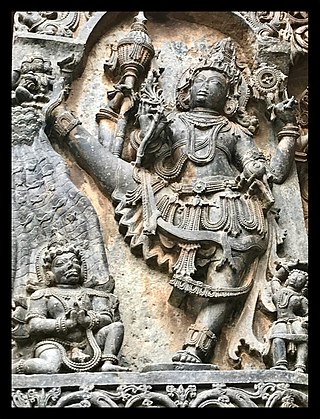Trailokya
Three planes of existence in Indian religious cosmology From Wikipedia, the free encyclopedia
Trailokya (Sanskrit: त्रैलोक्य; Kannada: ತ್ರೈಲೋಕ್ಯ; Pali: tiloka, Tibetan: khams gsum; Chinese: 三界; Vietnamese: Tam Giới) literally means "three worlds".[1][2][3] It can also refer to "three spheres,"[3] "three planes of existence,"[4] and "three realms".[4]

Various schemas of three realms (tri-loka) appear in the main Indian religions of Hinduism, Buddhism and Jainism.


Hindu cosmology
The concept of three worlds has a number of different interpretations in Hindu cosmology.
- Traditionally, the three worlds refer to either the earth (Bhuloka), heaven (Svarga), and hell (Naraka),[5] or the earth (Bhuloka), heaven (Svarga), and the netherworld (Patala).[6]
- The Brahmanda Purana conceives them to be Bhūta (past), Bhavya (future), and Bhavat (present).[7]
- In Vaishnavism, the three worlds are often described to be bhūr, bhuvaḥ, and svaḥ (the gross region, the subtle region, and the celestial region).[8]
- In the Nilanamatapurana, Vamana covers his second step on the three worlds of Maharloka, Janaloka, and Tapaloka, all of which are regarded to be a part of the seven heavens.[9]
Buddhist cosmology
In Buddhism, the three worlds refer to the following destinations for karmic rebirth:
- Kāma-loka (world of desire), is a plane of existence typified by base desires, populated by hell beings, preta (hungry ghosts), animals, humans, lower demi-gods (asuras) and gods (devas) of the desire realm heavens.
- Rūpa-loka (world of form), a realm predominantly free of baser desires, populated by higher level devas. It is a possible rebirth destination for those well practiced in dhyāna (meditative absorption).
- Arūpa-loka (the world of formlessness), a non-corporeal realm populated with four heavens. It is a possible rebirth destination for practitioners of the four formlessness stages of meditation (arūpa-samāpatti).[3]
According to Theravada Buddhism, these are all the realms of existence outside of nirvana, which transcends all three realms. According to Mahayana Buddhism however, the buddhafields (also known as pure lands) are lands which are beyond the three realms.[10]
Jain cosmology
The early Jain contemplated the nature of the earth and universe and developed a detailed hypothesis on the various aspects of astronomy and cosmology. According to the Jain texts, the universe is divided into 3 parts:[11][12][13][14]
See also

Notes
Sources
External links
Wikiwand - on
Seamless Wikipedia browsing. On steroids.
